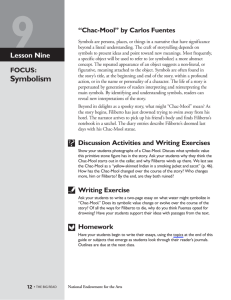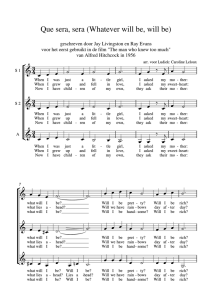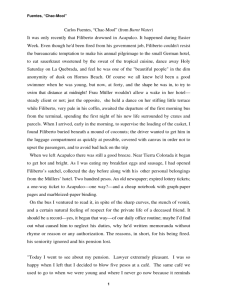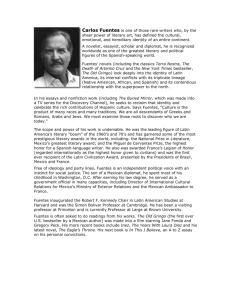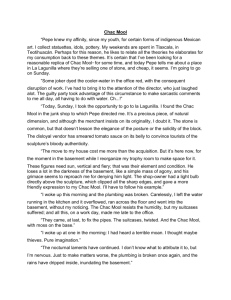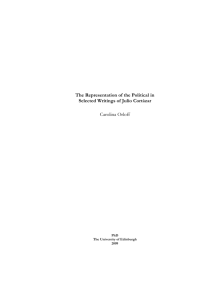Redalyc.Houses of Horror or Magical Kingdoms? Past Times
advertisement
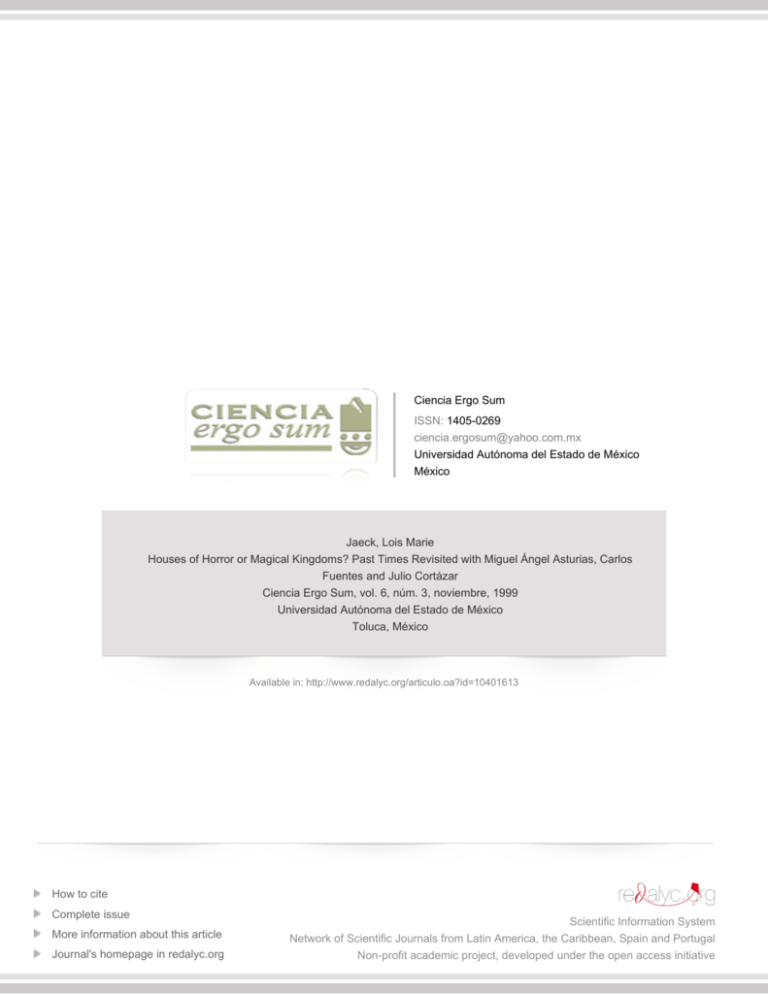
Ciencia Ergo Sum ISSN: 1405-0269 ciencia.ergosum@yahoo.com.mx Universidad Autónoma del Estado de México México Jaeck, Lois Marie Houses of Horror or Magical Kingdoms? Past Times Revisited with Miguel Ángel Asturias, Carlos Fuentes and Julio Cortázar Ciencia Ergo Sum, vol. 6, núm. 3, noviembre, 1999 Universidad Autónoma del Estado de México Toluca, México Available in: http://www.redalyc.org/articulo.oa?id=10401613 How to cite Complete issue More information about this article Journal's homepage in redalyc.org Scientific Information System Network of Scientific Journals from Latin America, the Caribbean, Spain and Portugal Non-profit academic project, developed under the open access initiative E N S A Y O HOUSES OF HORROR OR MAGICAL KINGDOMS? PAST TIMES REVISITED WITH MIGUEL ÁNGEL ASTURIAS, CARLOS FUENTES AND JULIO CORTÁZAR* LOIS MARIE JAECK** Recepción: 02 de junio de 1999 Aceptación: 29 de junio de 1999 Abstract. In the three short stories to be examined, Miguel Ángel Ángel Asturias, Asturias, Carlos Carlos Fuentes and Julio Julio Cortázar Cortázar incorporate incorporate PrePre-Columbian Columbian beliefsbeliefs and customs and customs into colonial into colonial and post-colonial and post-colonial Latin American Latin American reality. reality.fictional Their Their fictional mergers mergers of “past” of “past” and and “present” “present” insinuate insinuate the reversibility/ the reversibility/ ambiguity ofof dreams/representation dreams/representation with physical reality. They thus recognize recognize the the authentic presence of Pre-Columbian Pre-Columbian culture culture in contemporary Latin American societies societies and put into into question question the the validity validity ofof European/North American European/North American materialism. materialism. Introduction In “Leyenda de la tatuana ”, Guatemalan writer Miguel Ángel Asturias portrays the ancient religion of the Maya people giving rise to a triumph of individual will over oppression at the hands of Spanish colonizers. On the other hand, * A paper presented at the CALACS/CAM Congress 1998, Vancouver, Canada. March 21, 1998. ** Associate Professor of Spanish and Comparative Literature, Department of Languages and Linguistics, University of Saskatchewan, Canada. E-mail: jaecklm@duke.usask.ca 312 CIENCIA ERGO SUM Mexican writer Carlos Fuentes’ short story “Chac Mool ” depicts a twentieth century resuscitation of the Mayan god of the rains as a cruel, implacable taskmaster who murders with impunity, eats human flesh, and finally ends up revealing himself as a grotesque painted caricature of human sensuality and narcissism. In his short story “La noche boca arriba ”, the Argentine writer Julio Cortázar vacillates between two realities (a twentieth century surgical amphitheater and an Aztec sacrificial temple) in the context of the “awake” dreams experienced by the victim of a motorcycle accident. Cortázar infers a strange parallel between the two apparently distinct cultural communities when his character awakens into the reality of the Aztec sacrifice to realize that “the marvelous dream had been the other, absurd as all dreams are” (cf. 96). This paper will compare and contrast the depiction of Pre-Columbian religions in the above mentioned short stories, with a view to clarifying cultural conflicts that underlie some twentieth century Latin American societies. The theoretical point of departure for my analysis is predominantly a personal one, spanning the gap from the critical perspectives of Structuralism and Post-Structuralism, to Post Modernism. The duality of lived reality and dreams – so prevalent in PreColumbian beliefs – is explored in the three literary works to be examined. I. “Leyenda de la tatuana ” (Miguel Ángel Asturias) In “Leyenda de la tatuana ” (Leyendas de Guatemala, 1930), Miguel Ángel Asturias’ protagonist – el Maestro Almendro – is a priest of the ancient Mayan religion living under Spanish colonial rule who knows the secret of plants that cure everything, the vocabulary of obsidian (the stone that talks) and how to read the constellations (cf. 389). He also is el árbol que anda – a mythological being described in the Popul Vuh – the sacred book of the Mayas. The short story does not immediately dwell upon VOL. 6 NÚMERO TRES, NOVIEMBRE 1999-FEBRERO 2000 h o u s e s o f h o r r o r o r the conflict between Pre-Columbian and colonial Spanish religious beliefs and attitudes, but instead introduces a conflict between spirituality and mercantilism in the context of the mythical narration itself. After releasing his soul to the four caminos of the heavens, Maestro Almendro discovers that the black extremity – that of the magical night – has arrived in Xibalbá – the city of death – and given his one quarter of the Maestro’s soul to the Mercader de Joyas sin precio. The Maestro tries to buy back the lost portion of his soul by offering a lake full of emeralds in exchange, but the merchant refuses to comply; desiring to use the soul to procure the most beautiful slave girl in the world to be his mistress. After the merchant’s sudden death on his way home from the slave market (he is thrown into the “abyss” after his horse unseats him during a sudden mountain tempest), the slave girl returns to the city residence of the merchant, where the Maestro finally finds her and discovers that she is in fact the portion of his soul that was lost. Their mystical meeting (resembling that of “dos amantes que han estado ausentes y se encuentran”, 392) is interrupted almost immediately by soldiers of the Spanish colonial government who, in the name of God and King, arrest the Maestro for being a witch and the beautiful slave girl for being bewitched. The pair are condemned by the Inquisition of the Catholic church to burn to death in the Plaza Mayor. The night before their execution, the Maestro shows the slave girl how she can escape from her captivity and from death through the power of her mind. Tattooing a little boat onto her arm with his fingernail, he tells her that she will always be able to flee from any danger – like she is going to escape now – by tracing that little boat on the wall, on the floor, in the air or wherever she likes; then m a g i c a l k i n g d o m s ? p a s t entering into it and escaping. She does what the Maestro tells her to do, and escapes from the prison and from death. He in turn transforms himself back into an almond tree, and that is all that remains in the jail on the morning of the proposed execution. Miguel Ángel Asturias clearly is on the side of Mayan spirituality, lauding its victory over the Spanish colonial institutions represented by the soldiers and the civil justice system, and over mercantilism whose representative in this case is another character in Mayan mythology. Significantly, the Mayan Mercader de joyas sin precio is not materialistic in the European/North American sense of the word: he acknowledges the superiority of the soul over any kind of material wealth when he rejects the Maestro’s offer to buy back his soul in exchange for a lake full of emeralds. Instead, the merchant intends to exploit the “commercial” value of the soul that is a “jewel without price” in order to purchase beauty that is also beyond price. Both the Spanish colonial civil institutions and the commercial side of Mayan life are inept compared to the power of mind of Maestro Almendro, whose strength arises from his affinity with natural forces. In accordance with the teachings of the Popul Vuh, the Maestro is one with nature, changing himself from vegetal to human form at will. The Mercader, on the other hand, is damned by the cosmic forces of nature and thrown into the “abyss” by the roots of a tree that resemble a large hand. The circumstances giving rise to the merchant’s death introduce the arbitrary nature of signs into the previously mentioned conflicts between commercialism and spirituality, Mayan mythology and Spanish Colonial civil/ religious institutions. When the “black road” of the “magical night” gives his portion of the Maestro’s soul to the Mer- VOL. 6 NÚMERO TRES, NOVIEMBRE 1999-FEBRERO 2000 t i m e s r e v i s i t e d . . . cader, things appear to be that which they are not: “las nubes parecían ropas en los tendederos del cielo” (390). In the hour when the merchant refuses to relinquish the soul of the Maestro to its rightful owner, opposites (dream/reality, white cats/black cats, the merchant/the client) are separated only by an unsubstantial “hebra de humo” (391). This duplicitous nature of signs subsequently gives rise to the merchant’s annihilation. “Los dedos de una mano gigante” (391) that he interpreted as belonging to a god watching over him benevolently are in fact the roots of a tree that, struck by lightening and uprooted when the Mercader is thrown at its feet, grabs him and tosses him “como una piedra ” (393) into the abyss. The Mayan legend that underlies Asturias’ “Leyenda de la tatuana ” clearly favours beings who respect nature. As a result of his willingness to exploit commercially a being so in harmony with natural forces that he can transform himself into a tree, the Mercader condemns himself. This ambiguity of signs associated with mercantilism is in sharp contrast to the direct correspondence between signs and things that Maestro Almendro’s discourse gives rise to. By virtue of the power of his mind, the distinction between physical objects and their representations is abolished. His tattooed boat functions like a boat in physical reality by providing an opening, an escape from oppression and death: “Vete, pues mi pensamiento es más fuerte que ídolo de barro amasado con cebollín ” (393). II. “Chac Mool ” (Carlos Fuentes) Whereas Miguel Ángel Asturias presents Pre-Columbian Mayan culture and religion as a magical kingdom whose erudition and customs were oppressed by Spanish colonial CIENCIA ERGO SUM 313 E N S A Y O institutions in the physical, if not in the mental, realm, Carlos Fuentes’ “Chac Mool ” (Los días enmascarados, 1954) acknowledges the existing latent power of Pre-Columbian religious figures and customs in Latin America, but insinuates that to live with them in the context of twentieth century reality would be to live in a house of horrors. As if foreshadowing the macabre events that will follow, Fuentes’ story commences with news of the death of Filiberto, an insignificant civil servant who had a passion for collecting PreColumbian art. In a boarding house in Acapulco, Fuentes’ narrator finds among Filiberto’s meagre belongings a cheap exercise book that served as his journal. His writings describe changes in his life after acquiring an apparently genuine life-size statue of Chac Mool from a shady dealer of antiquities. Immediately after bringing home this work of art depicting the Mayan god of the rains, strange events began to happen: Filiberto’s basement flooded repeatedly for no apparent reason, the statue consequently grew mold in its lower surface, and terrible howls began to interrupt the silence of the night. After repeated exposure to moisture, the statue of Chac Mool became soft – a sign that it may have been plaster and thus a fake. After realizing that the Chac Mool had grown hair on its arms, its astounded “owner” next discovered that the statue had changed color from a bland beige to a golden yellow, as if indicating his godlike nature (cf. 496). One night, Filiberto had a bad dream, pretended to sleep, and then opened his eyes to the true nightmare – the animated statue of Chac Mool in the bedroom, moving towards the bed. Chac Mool subsequently took over the house, obliged Filiberto to be his servant and prisoner (cf. 497), and then dressed himself in his human servant’s clothing. After losing his mental 314 CIENCIA ERGO SUM stability, his credibility, his job, and being reduced to a life of base servitude, Filiberto found a big pile of animal bones behind a door. Realizing that Chac Mool left the house every night to hunt for live prey, Filiberto took advantage of his absence and fled to Acalpulco, taking refuge in an old boardinghouse where he used to go for vacations. Because it was the dry season, Filiberto recorded in his diary that he felt safe; as even with the numerous buckets of water that he had carried to keep the god moist, Chac Mool had started to dry out and have difficulty moving. Filiberto mistakenly thought that it was only a matter of time before the “god” was reduced once again to the immobility of a statue. Human logic failed the test and Filiberto was found mysteriously drowned. When the narrator returns to Filiberto’s family residence with the body of the deceased in a coffin, he is prevented from entering by a repulsive yellow Indian wearing a dressing gown and smelling of cheap lotion, who tells him that he knows everything and to please put the coffin in the basement. Filiberto’s death by drowning during holy week subtly insinuates that the latent power of Pre-Columbian religious beliefs may outweigh even Catholicism in twentieth century Mexican culture. Immediately prior to obtaining the statue of Chac Mool in the back street shop of Lagunilla, Filiberto had proposed in his journal that the common ground shared by Catholicism and the Aztec religion is blood sacrifice, and that the aboriginal Mexican people never would have been so readily converted to Christianity if not for that common essential nature: “Llegan los españoles y te proponen adores a un Dios, muerto hecho un coágulo, con el costado herido, clavado en una cruz. Sacrificado. Ofrendado. Qué cosa más natural que aceptar un sentimiento tan cercano a todo tu ceremonial, a toda tu vida…un Dios al que no le basta que se sacrifiquen por él, sino que incluso va a que le arranquen el corazón, caramba, ¡jaque mate a Huitzilopochtli! El cristianismo, en su sentido cálido, sangriento, de sacrificio y liturgia, se vuelve una prolongación natural y novedosa de la religión indígena ” (493). In his video documentary The Buried Mirror (1991), Carlos Fuentes has sug gested that Pre-Columbian architecture (and the culture that it represents) is a living presence in Mexico that co-exists alongside twentieth century buildings and ideology. Just as Filiberto could not leave the old house that was too big for him because it was the “única herencia y recuerdo de (sus) padres ” (495), so Mexico cannot forsake the gods, myths and superstitions of its Pre-Columbian past, as they are part of the country’s subconscious self, residing just below the surface of contemporary reality. Speaking about Pre-Columbian art in Tiempo Mexicano (1971), Fuentes has sug gested that it elaborates an incredibly ample time and space which comprehends the implacable circularity of the cosmos (cf. 18): “Cada piedra, cada templo, cada escultura del México antiguo son algo más que el signo pragmático de una sociedad teocrática: son los recipientes de esa espera desesperada: el regreso de Quetzalcóatl, un retorno al origen sin separación, idéntico con un futuro bienhechor ” (22). Like a grotesque parody of Fuentes’ later interpretation of ancient Mexican sculpture, the statue of Chac Mool in the short story of the same name appears to have the power to return Filiberto to his “origins”. The civil servant’s first observations of the work of art in his basement engendered mental perturbations and anxiety that gave rise to a childlike writing style (495). Prolonged contemplation of the statue resulted in Filiberto’s loss of contact VOL. 6 NÚMERO TRES, NOVIEMBRE 1999-FEBRERO 2000 h o u s e s o f h o r r o r o r with his previous twentieth century reality and his subjugation to a cruel implacable god who held him in bondage through fear, much like the old Aztec gods did to their ancient worshippers. In the half-mad state that Chac Mool’s presence conducted him to, Filiberto mused on the difference between reality and illusion. He concluded that representations or reflections of reality (the sound of the ocean induced by a seashell, for example) are truer than their signified concept: “Océano libre y ficticio, sólo real cuando se le aprisiona en un caracol ” (496). His reference to another reality that we knew was there, that may suddenly one day reveal itself to us, suggests the chance discoveries of ancient Mexican structures which have emerged into twentieth century reality during excavations for new building projects or during the opening up of the earth by earthquakes: “Y luego, como la tierra que un día tiembla para que recordemos su poder, o la muerte que llegará, recriminando mi olvido de toda la vida, se presenta otra realidad que sabíamos estaba allí, mostrenca, y que debe sacudirnos para hacerse viva y presente ” (496). As the prisoner and servant of Chac Mool , Filiberto realized that the “god” was falling into human temptations – drinking wine, desiring women, trying to enhance his appearance with lotions – and consequently was losing his “eternal” aspect – starting to look old (498). Because Chac Mool needed animal flesh to sustain himself, the bedroom that he took over stank of incense and blood (reminiscent of the Aztec temples described in Bernal Díaz de Castillo’s Historia verdadera de la Conquista de la Nueva España, cf. p. 217). The repulsive indio amarillo who greets the narrator when he returns to the house with Filiberto’s body is Fuentes’ personification of the timeless ugliness of suppression and materialistic m a g i c a l k i n g d o m s ? p a s t exploitation that was inherent in PreColumbian religious beliefs and civil institutions as well as in contemporary society. Speaking of the intricate social hierarchy of the Mayas, where leaders at the top in rich attire were supported by a bureaucracy and an army that maintained control over the masses at the bottom, Fuentes has commented in The Buried Mirror that “this is Mayan life with an all-too-human face” (Video 6 min. from 00:00). Fuentes also has suggested that the Aztec’s guerra florida, apparently fought on religious grounds in order to maintain the sun in the sky through the constant sacrifice of human lives, had another very practical economic function in Aztec culture: it kept neighboring aboriginal nations in constant terror of Aztec power (cf. Video at 12:20 min. from 00:00) while guaranteeing tribute from them in the form of goods, services and human lives (See also Serge Gruzinski’s The Aztecs: Rise and Fall of an Empire, pp. 52-54). III. “La noche boca arriba ” (Julio Cortázar) The epilogue introducing Julio Cortázar’s “La noche boca arriba ” (Final del juego, 1966) mentions the Aztecs’ custom of hunting victims of neighboring nations for human sacrifice: “Y salían en ciertas épocas a cazar enemigos; le llamaban la guerra florida ” (88). Just as Fuentes in “Chac Mool ” suggested that the ritual of blood sacrifice was an innate similarity linking Christianity and Pre-Columbian religions, so Cortázar has established subtle parallels between a twentieth century surgical amphitheater and an Aztec sacrificial ceremony on top of a pyramid. Past/present common denominators insinuate themselves to Cortázar’s reader through the story’s alternating depictions of “awake” and “dream” realities experienced by the victim of a VOL. 6 NÚMERO TRES, NOVIEMBRE 1999-FEBRERO 2000 t i m e s r e v i s i t e d . . . motorcycle accident in an unnamed city, apparently in Mexico. The “chance” accident could have been avoided with more human care and attention. A moment of distraction on a beautiful day results in a motorcyclist colliding with a female pedestrian who suddenly steps into the street, even though the traffic light is not in her favor. Upon impact, the driver at first loses consciousness (“Fue como dormirse de golpe ”, 89) but regains it. In the hospital, he is x-rayed and pushed into surgery. He is aware of the smell of the hospital and also notes that the man in white has something gleaming in his right hand (cf. 90). After that point in the narration, the unnamed protagonist falls in and out of dreaming that he is a Moteca warrior attempting to elude an Aztec hunting party in ancient Mexico. The dreamer awakens to the physical reality of the hospital ward for brief intervals when the tension of his nightmare becomes too unbearable: “Se va a caer de la cama –dijo el enfermo al lado–. No brinque tanto, amigazo ” (91). The injured man vacillates three times from an awake state in the hospital to his nightmare reality of a PreColumbian religious ritual that progresses from being hunted in a swamp like an animal, to being captured and pinned down on dank, icy stone slabs of an underground cell in Teocalli, to being transported face up in a dark passageway toward a glimmer of torchlight; knowing that, when the stars appear instead of the roof, it will be his end. His final jump back into the physical reality of the hospital night to the sound of his neighbors peacefully snoring ends when he can no longer resist falling asleep and returns to the reality of the dream – the black emptiness of the passageway leading to the sacrificial temple on the top of the pyramid: “el pasadizo seguía interminable, roca tras roca, con súbitas fulguraciones rojiCIENCIA ERGO SUM 315 E N S A Y O zas, y él boca arriba gimió apagadamente porque el techo iba a acabarse ” (96). Realizing that he is being carried to the sacrificial stone dripping with blood immediately in front of him, he makes one last desperate attempt to wake up in the hospital bed, thinks that he has succeeded but then sees the bloodsoaked figure of the executioner-priest coming toward him with the stone knife in his hand. He realizes, in this final moment before his death, that he is not going to wake up in the hospital because he already is awake; that the marvelous dream had been the hospital and the city with red and green lights, where he had whirred around on an enormous metal insect, until that day when they had picked him up off the ground (cf. 96). He realizes, in his PreColumbian “awake” reality, that someone also had approached him with a knife in his hand in the reality of the sueño maravilloso (96) that took place in a twentieth century hospital. The “man with a knife” common to both epochs – the doctor in the twentieth century surgical amphitheater and the Aztec executioner-priest on top of a pyramid in Pre-Columbian Mexico – creates a metaphor-like correspondence between those distinct cultural realities and circumstances that invites speculation on their innate similitude. In both cases, the victim apparently dies “under the knife”. In the context of the twentieth century hospital, the doctor apparently was trying to use surgery to preserve the motorcyclist’s life (which a medical practitioner would regard as sacred) but was unsuccessful. In the case of the Pre-Columbian sacred ritual, the priest was going to cut out his victim’s heart, all the while believing that he was doing the victim a favor by assuring him a place in the afterlife. Serge Gruzinski, in The Aztecs: Rise and Fall of an Empire, has suggested that “the most enviable fate, and the one closest 316 CIENCIA ERGO SUM to Aztec vocation, was to die in combat or on a sacrificial stone. By such means one would join the sun in its triumphal march. This belief was the justification for a century of the Wars of the Flowers” (36). Contemplating the void between the impact of his accident and the moment he remembered people picking him up off the street, the motorcyclist felt that this void “had lasted an eternity” and that, in this void, he had “passed across something or had run back immense distances”: “Entre el choque y el momento en que lo habían levantado del suelo, un desmayo o lo que fuera no le dejaba ver nada. Y al mismo tiempo tenía la sensación de que ese hueco, esa nada, había durado una eternidad. No, ni siquiera tiempo, más bien como si en ese hueco él hubiera pasado a través de algo o recorrido distancias inmensas ” (94). Like Fuentes in “Chac Mool ”, Cortázar infers that Mexico’s PreColumbian past is such a vital part of twentieth century Mexican culture that the two times literally co-exist in the same physical space. Losing consciousness facilitated Cortázar’s protagonist’s awareness of a past cultural reality existing below the surface of the modern city as architectural ruins and in the subconscious of the modern Mexican psyche, where the grandeur of the Aztec empire as well as the atrocities that sustained it are a living presence. Cortázar’s story infers that past events can emerge into the context of the present through the intermediary of elements common to both times, notwithstanding the good or bad intentions in the past or the present that gave rise to the similar circumstances. Like Pre-Columbian mythologies (cf. Conversaciones con Miguel Ángel Asturias, 164), Cortázar’s story illustrates that the difference between lived physical reality and dreams (or literature) resides within the context of human perception. If Cortázar’s motorcyclist dreamed that he was having his heart cut out in an ancient sacrificial ceremony at the moment that his heart stopped in his physical reality of a twentieth century hospital, his final “reality” as he perceived it and “experienced” it would be that of the “dream”. IV. Past Times Revisited with Asturias, Fuentes and Cortázar Whereas Fuentes and Cortázar apparently regard with caution the blood-letting rituals that frequently were a part of Pre-Columbian religious practices, Asturias endorses the spiritual strength and alignment with natural forces that characterized many Mesoamerican Pre-Columbian beliefs. After 1930, Asturias sometimes wrote novels and short stories of a more blatantly political nature targeting American imperialism and corrupt Latin American military dictatorships, such as the one portrayed in El Señor Presidente (1946). Nonetheless he continued to include elements of Mayan cosmology as the basic structural element of many literary works. Hombres de maíz (1949) amplified the conflict between mercantilism and nature that was introduced in “Leyenda de la tatuana”. In his Introduction to Conversaciones con Miguel Ángel Asturias, Luis López Álvarez comments: “Asturias había de definir su intento al escribir Hombres de maíz diciendo que ‘se inspira en la lucha sostenida entre el indígena del campo, que entiende que el maíz debe sembrarse sólo para alimento, y el hombre criollo que lo siembra para negocio’ ” (17). In a conversation with López Álvarez, Asturias stated that his literary works portraying conflicts between PreColumbian and European cultures were a reflection of his internal struggles as a “mestizo”. As a writer, he saw himself committed to consoling those warring VOL. 6 NÚMERO TRES, NOVIEMBRE 1999-FEBRERO 2000 h o u s e s o f h o r r o r o r factions by writing about indigenous desires in Spanish: “Yo soy mestizo y tengo la parte indígena, y esa parte lucha con mi parte española, si se quiere decir así, a efecto que, usando mi español, yo exprese lo que el indígena quiere, y ésta es una de las formas de la literatura mestiza. Es por eso que he tratado en estos libros, como en Hombres de maíz o en Mulata de tal, de revivir todos los mitos, de revivir todas las creencias, de recrear todas las leyendas, buscando siempre y recordando siempre lo que al pueblo oí ” (163). Recognizing that Pre-Columbian culture was a vital force in the subconscious reality of Latin America, Asturias advocated the necessity of Latin American writers acknowledging their aboriginal roots, and further suggested in 1973 that the surrealistic movement in art and literature had helped them to do so: “Para nosotros el surrealismo representó (y ésta es la primera vez que lo digo, pero creo que tengo que decirlo) el encontrar en nosotros mismos no lo europeo, sino lo indígena y lo americano, por ser una escuela freudiana en la que lo que actuaba no era la conciencia sino el inconsciente. Nosotros el inconsciente lo teníamos bien guardadito bajo la conciencia occidental. Pero cuando cada uno empezó a registrarse por dentro se encontró con su inconsciente indígena, lo que nos proporcionó la posibilidad de escribir…” (80). Asturias saw the “magical” part of his literary work – its combination of dream and lived reality, the real and the unreal – as a means of expressing an authentic indigenous view of the world: “Es decir que no puede hablarse de este realismo mágico sin pensar en la mentalidad primitiva del indio, en su manera de apreciar las cosas de la naturaleza y en sus profundas creencias ancestrales ” (166). Asturias stressed that Pre-Columbian Mesoamerican beliefs frequently did not distinguish between lived and dreamed experiences (cf. 164). Traditional Indigenous storytellers, according to Asturias, can m a g i c a l k i n g d o m s ? p a s t transform “lo que es un hecho real en una leyenda y lo que es una leyenda en un hecho real ” (164) by giving such detailed accounts of their dreams or hallucinations that these details converge to make a dream more real than reality itself (cf. 166). Similarly, Carlos Fuentes’ “Chac Mool ” and Julio Cortázar’s “La noche boca arriba ” illustrate the breakdown of the distinction between physical reality and dreams that was a cornerstone of Pre-Columbian indigenous beliefs. Whereas the “awake nightmare” reality of Carlos Fuentes’ “Chac Mool ” would appear to be a reminder of the dark side of Pre-Columbian spiritual beliefs, it also is a recognition of the very real latent power that those beliefs wield in contemporary society and the danger of underestimating or trivializing that power. Seduced by twentieth century advertising, Fuentes’ fictional resuscitated version of Chac Mool adorns himself with western style clothing and uses lotions and makeup to help his complexion. Thus the former mighty Mayan god of the rains becomes a grotesque caricature of human sensuality and narcissism. In Tiempo Mexicano (1971) – seventeen years after “Chac Mool ” was published – Fuentes analyzed the conflict inherent in a society that has superimposed occidental commercialism on Mesoamerican mythical foundations: “Los carcomidos muros de adobe de los jacales en el campo mexicano ostentan, con asombrosa regularidad, anuncios de la PepsiCola. De Quetzalcóatl a Pepsicóatl: al tiempo mítico del indígena se sobrepone el tiempo del calendario occidental, tiempo del progreso, tiempo lineal ” (26). While Fuentes’ “Chac Mool ” (1954) left its reader with the impression that Columbian reality was better left dead and buried, his Tiempo Mexicano (1971) stresses that aboriginal culture possesses many keys to combat modern VOL. 6 NÚMERO TRES, NOVIEMBRE 1999-FEBRERO 2000 t i m e s r e v i s i t e d . . . neuroses, and that the knowledge of “Quetzalcóatl” should not be sacrificed to “Pepsicóatl” (cf. 36-37). Like Asturias, Fuentes advocates the undesirability of passively accepting North American materialism and calls on the Mexican people to invent their own social model; a synthesis of four times and cultures including indigenous mythical cosmic conceptions, the roman tradition of legitimacy and continuity that Spain converted into a transcendental project, epicurian individualism and stoicism, and the rational, empirical positivism taken from England, France and the United States (cf. 39): “Imposible Quetzalcóatl, indeseable Pepsicóatl: los mexicanos tenemos la obligación y la posibilidad de inventarnos un modelo propio de vida, una gran síntesis novedosa de los tiempos que nos han marcado, a fines de insertarnos en el tiempo de nuestra memoria, nuestra aspiración y nuestra justicia verdaderas ” (38). Conclusion Guatemala’s Miguel Ángel Asturias, Mexico’s Carlos Fuentes and Argentina’s Julio Cortázar share a passion for expressing and combining simultaneously different levels of reality in their literary works, with a view to relegating the difference between dream and reality to the domain of human perception. They also share the conviction that Latin America must learn to express its own reality that is neither European nor North American. Cortázar’s experimental novel Rayuela offers a clue to understanding the fallacy of materialism that resides at the base of Asturias’s, Cortázar’s and Fuentes’ explorations of Latin American reality. Rayuela tells the story of an Argentine intellectual who goes to Paris to find his cultural roots. Failing to do so, he returns to Buenos Aires where he finds himself equally alienated, and apparently commits suiCIENCIA ERGO SUM 317 E N S A Y O cide as a result. Unlike his unfortunate character, Cortázar realized, after years of self imposed exile in France, that he had had to see Latin America from the perspective of the “Old World” in order to discover what the true roots of Latin American culture were. In Acerca de la situación del intelectual latinoamericano (Último Round) – an essay first published in 1967 – Cortázar declared that he was better informed in France about Latin American sociopolitical situations than were his friends living in Argentina, due to the North America’s domination of Latin American information services: “Para afirmarme en esta convicción me basta, de cuando en cuando, hablar con amigos argentinos que pasan por París con la más triste ignorancia de lo que verdaderamente ocurre en Cuba; me basta hojear los periódicos que leen veinte millones de compatriotas; me basta y me sobra sentirme a cubierto de la influencia que ejerce la información norteamericana en mi país y de la que no se salvan, incluso creyéndolo sincera- mente, infinidad de escritores y artistas argentinos de mi generación que comulgan todos los días con las ruedas de molino subliminales de la United Press y las revistas 'democráticas' que marchan al compás de Time o de Life” (269). In 1967, the French philosopher Jacques Derrida also suggested (from a purely theoretical perspective) that writing, by virtue of its representative nature, gives rise to an obscuring of its signified concept: “La représentation s’enlace à ce qu’elle représente, au point que l’on parle comme on écrit, on pense comme si le représenté n’était que l’ombre ou le reflet du représentant ” (“Linguistique et Grammatologie”, 54. The English translation is the following: “Representation mingles with what it represents, to the point where one speaks as one writes, one thinks as if the represented were nothing more than the shadow or the reflection of the representer”, “Linguistics and Grammatology”, 36). The innate power of writing to deceive – to obscure the distinction between a represented concept and its representation – is inherent in Cortázar’s acknowledgment of the North American media’s subliminal influence on Latin Americans’ knowledge of their own reality. This imperceptible substitution of “American dream” reflections for Latin American lived reality ironically reflects the reversibility of dream and physical reality, past and present in “La noche boca arriba ” and in Pre-Columbian religious beliefs in general. Just as the “American dream” in 1967 could determine how a Latin American in Argentina viewed what his own lived reality was, so the fictitious unnamed accident victim in “La noche boca arriba ” may have lived his whole life in the “mentira infinita ” (97) of the “sueño maravilloso ” (97) – the dream of the twentieth century technological society that appeared to be his “lived” reality – before awaking to a state of recognition of an underlying reality that ultimately could prove to be more authentic than twentieth century materialism. BIBLIOGRAPHY Asturias, M. A. in citations). This short story originally was Díaz del Castillo, B. (1984). Historia verdadera de la _____ El señor Presidente. Losada, Buenos Aires. published in Final del Juego. Editorial Sudame- Conquista de la Nueva España. Tomo I. Casa de 1948; Costa-Amic, México. 1946 (privately published). _____ (1949). Hombres de maíz. Losada, Buenos Aires. ricana S. A., Buenos Aires. 1956. las Américas, Cuba. _____ (1963, 1973). Rayuela. Editorial Sudame- Fuentes, C. _____ (1988). Chac Mool. Voces de Hispanoamérica: ricana, Buenos Aires. _____ (1969, 1974). “Acerca de la situación del Antología Literaria. Heinle Publishers, Boston. _____ (1988). Leyenda de la tatuana. Voces de Hispa- intelectual latinoamericano”, Último round. Si- (Edition referred to in citations). This short noamérica: Antología Literaria. Heinle Publishers, glo XXI Editores, S. A., Mexico. This letter, story originally was published in Los días en- Boston. (Edition referred to in citations). This addressed to Roberto Fernandez Retamar, mascaradas. Los Presentes, México. 1954. short story originally was published in Leyen- originally was published in Revista de la Casa _____ (1971, 1975). Tiempo mexicano. Editorial das de Guatemala. Oriente, Madrid. 1930. Joaquín Mortíz, S. A., Tabasco, México. de las Américas. Habana, Cuba. 1967. _____ (1963). Mulata de tal. Losada, Buenos Aires. Derrida, J. Cortázar, J. _____ (1991). The Buried Mirror. (Video Produc- _____ (1967). “Linguistique et Grammatologie”, tion, written and presented by Fuentes, Car- _____ (1969). La noche boca arriba. Cinco Maestros: De la Grammatologie. Editions de Minuit, Paris. los. Directed by Rolling, Christopher). A Cuentos modernos de Hispanoamérica. San Diego, _____ (1974, 1976). “Linguistics and Gramma- New York, Chicago, Atlanta, Washington D. tology”, Of Grammatology. Translated by Spivak, Gruzinski, S. (1992). The Aztecs: Rise and Fall of an C., London, Sydney, Toronto: Harcourt Brace Gayatri Chakravorty. The John Hopkins Empire. Translated from the French by Bahn, Jovanovich, Publishers, (Edition referred to University Press, Baltimore and London. Paul. Harry Abrams, Inc., New York. 318 CIENCIA ERGO SUM Sogotel Production. VOL. 6 NÚMERO TRES, NOVIEMBRE 1999-FEBRERO 2000
